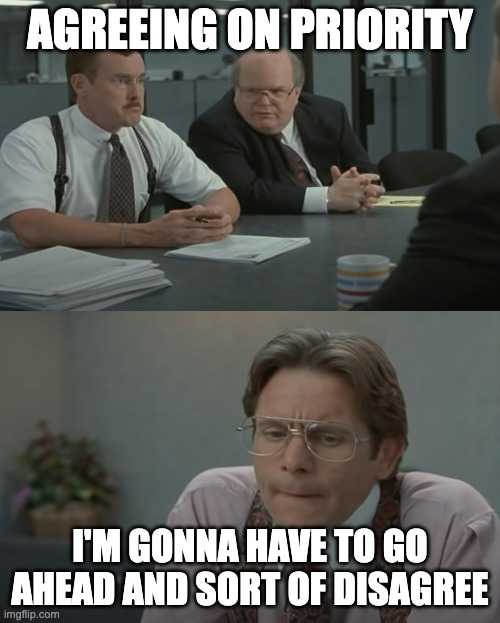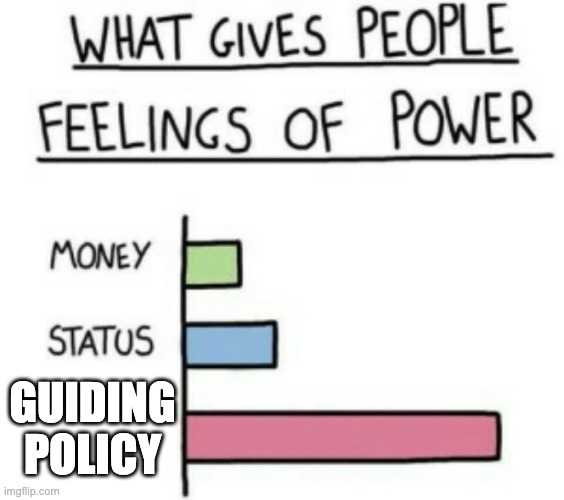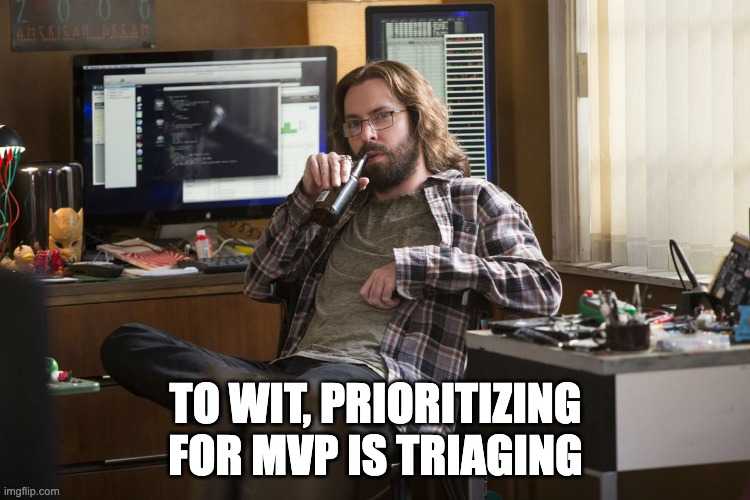
Prioritization is a perplexing thing. It's a universally familiar term. However, when people attempt to prioritize anything — it becomes surprisingly hard to do. Even if they don't end up arguing, the typical outcome of a prioritization exercise is a pile of tasks assigned to a particular bucket like P0, P1, P2 or P3 — corresponding to Critical, High, Medium and Low priority. Usually, this will yield enough confidence to feel satisfied and to believe that the job is done and everything is clear. But before long, it'll be clear that nothing is clear at all. Why is that?
In this blog post, we're going to dive into case studies of two Canadian startups to explore:
- Why is it so hard to agree on priority?
- Why using priority buckets for product work is a waste of time when building a Minimum Viable Product (MVP).
- Why without a strategy, prioritization turns into randomization.
But let's start with the definition of prioritization.
So what is prioritization?
If you ask the internet or an actual human for a definition of prioritization, you will get an answer that it's the process of arranging tasks in order of importance or urgency.
There is so much to unpack here...
First, the definition of prioritization doesn't prescribe how to do it. In other words, we have to come up with our own function that takes a unit of work along with multiple other parameters and returns a numeric value. But how do we even determine the importance or urgency of a unit of work so that we have a numerical value associated with it?
This is where prioritization becomes more art than science. Unfortunately (for data-driven people), many parameters supplied to a prioritization function are subjective, qualitative and contextual. In other words, it's impossible to be precise with a priority score — as different people would assign different scores to the same facts. It's easier to agree that an issue feels like a High priority than making a strong enough argument that it scores precisely 794 points. A High priority issue usually feels like a High priority, but 794 points don't feel like anything. And this is how we end up with four priority buckets of work.
Prioritization: A snapshot of today's context
When we lay out our work, breaking it down into tasks and deliverables, they seem pretty fixed at the outset. We're basing everything, including prioritization, on the current circumstances and environment — our knowledge, goals, understood customer needs, partnerships, and market trends. Moreover, our roadmap and backlog are also part of this environment and also affect each other.
But as time passes, things change. We learn new stuff, understand our customers better, observe how the market evolves and change our opinions and beliefs. And many of these opinions and beliefs are part of our priority assessment function. So if we take a unit work that in the past scored High, 794 points priority, and try to assess its priority nowadays — it's not guaranteed to get the same score. It may, but it may not. What felt important in the past may look insignificant now. And vice versa — what we thought was minor — is a big deal today. Some things will turn out entirely wrong despite the original vision staying correct! Pretty much like in 1865 Jules Verne thought that you would need a cannon to send Neil Armstrong to the Moon.
Priority buckets
Have you ever experienced that uneasy sensation after ignoring another issue of low importance, sensing that there is a growing pile of medium and low-priority tasks being neglected, which could eventually become overwhelming — like an iceberg tipping over and engulfing everyone beneath it? That's what priority buckets do.

Do you know what else prioritization with buckets does? It creates this mindset leading to a "good enough" culture of mediocrity where aiming for greatness takes a back seat. Trying to nail something awesome, or even hit that elusive perfection, means you've got to sweat the small stuff too. Ignoring low-priority issues means settling for less than the best. It's hard to feel proud of your own work when you know about all the imperfections it comes with.
I didn't intend for the previous paragraph to come across as if I were on a high horse, giving a TED talk. Priority buckets are still a valid tactical instrument for triage during crisis management, but they should not be your strategic prioritization tool.
The Eisenhower Matrix
Similarly, the famous Eisenhower Matrix is also a tactical tool. It's so tactical that it's better described as a tool for triage rather than prioritization:
- Important and urgent — do now.
- Important, not urgent — schedule for later.
- Not important, urgent — delegate.
- Not important, not urgent — delete.
Strategic prioritization
Strategic prioritization merges strategy and prioritization into a single, unified concept. We've already introduced a definition of prioritization, so let's introduce one for strategy.
What is strategy
Strategy is a framework that consists of three key elements:
- Diagnosis — identifying and defining the challenge that stands in the way of achieving our goal. The true challenge lies in the reasons behind the issues, not just in their symptoms.
- Guiding Policy — an overall approach for dealing with the challenge identified in the diagnosis. This guiding policy outlines how to address the challenge, essentially setting the direction or approach without detailing the specifics.
- Coherent Actions — a set of actions dictating how the Guiding Policy will be carried out. The actions should be coherent, meaning that the use of resources, policies, and steps should be coordinated and support each other (not defy or be independent from one another).
A good strategy has all three elements and leverages the sources of power within the organization against opportunities or challenges.
Bad Strategy
Bad strategy is almost a literary form that uses PowerPoint slides to say: "Here is how we will look as a company in three years." The bad strategy takes two principal forms:
- "Dog's dinner objectives" contain every suggestion made at planning meetings and listing, sometimes hundreds of uncoordinated, incoherent actions, objectives and key results (OKR).
- "Blue sky objectives" is a restatement, usually full of fluff and inflated words of the desired state of affairs. It skips over the annoying fact that no one has a clue as to how to get there.
To learn more about strategy I highly recommend Richard Rummelt's book Good Strategy Bad Strategy: The Difference and Why It Matters" and his interview at Lenny's Podcast.
So what is strategic prioritization?
You probably already guessed that strategic prioritization is a subset of the third element of strategy — Coherent Actions. Coherent Actions do not exist without a Guiding Policy, which cannot be conceived without a Diagnosis. If we cannot tell what challenge we are trying to overcome and do not have a general approach to overcome that challenge — there is nothing strategic about our actions, and we are totally rogue and random.

Prioritization: The art of making less random choices
Imagine, we are creating a Minimum Viable Product (MVP) to validate a business idea. It's worth noting that the RICE framework, another tactical prioritization tool for product managers created by Sean McBride at Intercom, is not suitable when developing an MVP. The goal of an MVP is straightforward: to demonstrate with minimal resources and effort that a problem exists, can be addressed with a proposed solution and that customers are willing to pay for it. In this context, factors such as Reach, Impact, and Confidence, central to the RICE framework, are not particularly relevant.
Case studies
To showcase the importance of the Diagnosis and how vastly different Guiding Policies can be depending on the outstanding challenge, let's examine two distinct companies building their MVPs and contrast their challenges and guiding policies against each other.
Looplay
Looplay is a Montreal-based service, designed for sports facilities to increase their revenue, customer loyalty, and social media exposure by offering automated recording of games and highlights. It redefines the market category by offering automated highlight reels to casual players and recreational sports enthusiasts — a perk that was once only for the pros with deep pockets.
Looplay's Diagnosis
Looplay confronts the classical challenge of democratizing a technology. It requires significantly lowering the cost of deployment of such a technology — by orders of magnitude — as well as reducing the associated risk of messing up for the buyers to the levels typically associated with consumer products.
Looplay's Guiding Policy
Looplay's challenge is also Looplay's opportunity. If solved, it becomes their economic moat against the established incumbents who target professional sports organizations.
To meet risk and budget constraints, Looplay needs to focus on supporting cheap, mass-market cameras and other equipment in an agnostic way to eliminate the cost of supporting native protocol variations.
The actual highlights, such as when a player scores an impressive goal or makes a skillful move, carry a disproportionally high value yet take only a short duration of the overall game footage. For Looplay, the risk of missing even one such highlight equates to the potential loss of a customer, making it imperative to prioritize resilience to slow and unreliable network conditions.
FISPAN
FISPAN, a fintech startup from Vancouver, designed to increase transactional and deposit revenues for its partnering banks by integrating banks' treasury services into end-users' ERP and accounting systems. It breaks the industry status quo by converging business banking and accounting, traditionally seen as separate workflows, into a unified, seamless experience — hence, its logo is a stylized hypercube.
FISPAN's Diagnosis
FISPAN's challenge is twofold: Firstly, the amplified risk inherent in financial transactions demands increased attention to compliance, security, and traceability. Secondly, challenging the established norms and processes can be difficult. Convincing individuals to shift from their current methods to new technological solutions and educating them about the advantages is particularly tough.
FISPAN's Guiding Policy
Being between the hammer of a highly regulated financial industry and a hard place of procurement processes that are decades old, FISPAN's challenge is, first and foremost, to showcase that its information security practices earn FISPAN the right to participate in payments and vendors' information exchange between banks and other legal entities.
Any given moment in the life of a piece of information — whether it's a payment instruction, vendor's information or FISPAN's own source code — must be explainable, predictable, traceable and transparent, backed up and ready for disaster recovery.
To drive the adoption of a new solution that modifies the decades-old practices in a very conservative industry, FISPAN should simplify onboarding and minimize the learning required for the users. Instead of "You used to do X here, now you need to do Y" — it should be "You used to do X here, now you don't need to do anything."
Prioritize features for MVP with Guiding Policies
Just reading the guiding policies for both companies gives a good idea of how to prioritize work. For example, Looplay doesn't need to work on supporting the gear used at Madison Square Garden, and FISPAN doesn't need to support credit card payments in MVP and can start with ACH payments because they constitute a significantly larger share of business-to-business transactions compared to credit cards and would not require compliance with even more hardcore PCI (Payment Card Industry Data Security Standard).
In other words, conformity with the guiding policies helps you decide what should and shouldn't be prioritized. However, building an MVP (minimum viable product) is more similar to working on a fixed-scope project (by definition — minimum). Therefore, if you removed a feature from your product but can still demonstrate unlocking value for the customers and meeting their expectations — that feature didn't belong to the MVP. By the way, meeting the baseline industry expectations is an essential requirement for an MVP. That's why we can't cut compliance work or make ugly user interfaces.
MVP prioritization

Hence, prioritizing work for MVP is not assigning it to priority buckets, it's deciding in binary without gradients: What should and shouldn't be in your MVP. It's relentless but tasteful cutting and trimming to save time and money for finding customers and letting them validate the MVP. However, ensure your challenge is well defined and properly diagnosed.